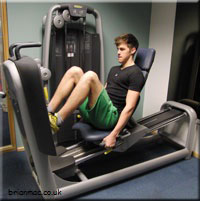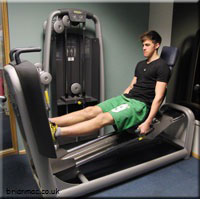

Leg Press Test
Testing and measurement are the means of collecting information upon which subsequent performance evaluations and decisions are made. In the analysis, we need to consider the factors influencing the results.
Objective
The leg press test aims to evaluate an athlete's leg strength.
 |
 |
Required Resources
To conduct this test, you will require:
- Leg Press Machine
- Weighing Scales
- Assistant
How to conduct the test
This test requires the athlete to complete as many leg presses as possible with no rest.
- The assistant weighs and records the athlete's weight.
- The athlete warms up for 10 minutes.
- The assistant loads the barbell with a weight close to the athlete's one-repetition maximum load.
- The athlete conducts leg presses until they are unable to continue.
- The assistant counts the number of successful leg presses.
- If the number of leg presses exceeds eight, then the athlete rests for 10 minutes, the assistant increases the barbell weight, and the athlete repeats the test.
- The assistant uses the maximum load calculator to determine the athlete's 1RM.
Analysis
Analysis of the test result compares it with the athlete's previous results for this test. It is expected that the investigation would indicate an improvement in the athlete's leg strength with appropriate training between each test.
A good 1RM for the leg press is 2.5 × "Body Weight" for men and women.
Target Group
This test is suitable for active individuals but not for those where the test would be contraindicated.
Reliability
Test reliability refers to how a test is consistent and stable in measuring its intended measure. Reliability will depend upon how strictly the test is conducted and the individual's level of motivation to perform the test. The following link provides various factors influencing the results and therefore, the test reliability.
Validity
Test validity refers to the degree to which the test measures what it claims to measure and the extent to which inferences, conclusions, and decisions based on test scores are appropriate and meaningful. This test provides a means to monitor training on the athlete's physical development.
Advantages
- Minimal equipment required.
- Simple to set up and conduct.
- The athlete can administer the test.
Disadvantages
- Specialist equipment required.
- Assistant required to administer the test.
References
- McARDLE, W. et al. (2000) Essentials of Exercise Physiology. 2nd ed. Philadelphia: Lippincott Williams & Wilkins p. 394
Page Reference
If you quote information from this page in your work, then the reference for this page is:
- MACKENZIE, B. (2001) Leg Press Test [WWW] Available from: https://www.brianmac.co.uk/lpress.htm [Accessed